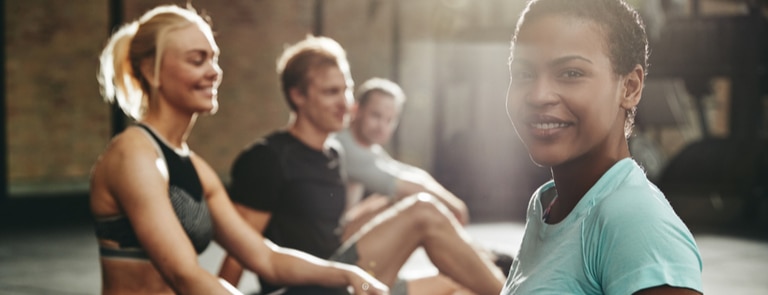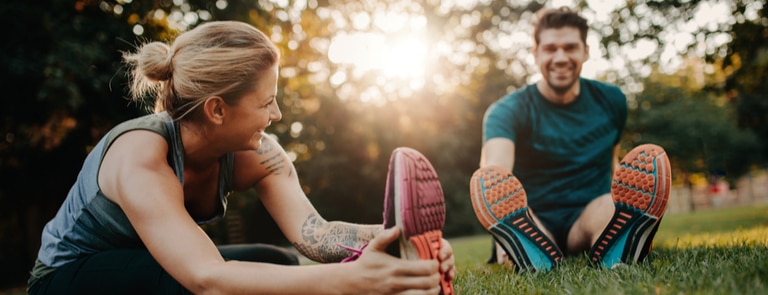The benefits of dynamic stretching
If you struggle with muscular pain during your workout, it might be time to switch up your warm-up routine. Here, we’ll talk about dynamic stretching and how it can help you with your workout.
What is dynamic stretching?
Dynamic stretching is the use of movement to warm up specific muscles, getting them pumped and ready for exercise. It’s different from normal static stretching as it takes movements like squats and lunges and transforms them into stretches.1
Over recent years, dynamic stretching may have overtaken static stretching as it can prepare specific muscles ahead of a workout. It’s performed at a slower pace as preparation for exercise, which means you are looking to stimulate muscles or muscle groups to get them prepared for more intense exercise.
For example, in preparation for a run you may wish to prepare the knees so you may carry out some high knee or squat exercises in preparation.
We’ll go over some stretches, and more specifically the benefits within this article.
What is static stretching?
Static stretching is the movement you would generally attribute to a workout. It can be done at the beginning of a workout as a warmup, although static stretching would be more commonly be done at the end of a workout to warm down the muscles you have used with prolonged stretches.
It works by placing a certain muscle where it can be extended and holding it there for a certain amount of time.2
Dynamic versus static stretching
Both dynamic and static stretching have their place as part of your fitness routine. Typically, dynamic stretching would be something you do at the beginning of your workout as it involves actively working your muscles ahead of exercise.
Often these movements will often stretch the same muscles you will be training in your workout. For example, a swimmer may look to warm up the arms and the runner their legs etc.
Whereas static stretching would usually be carried out at the end of your workout. This involves stretches that you hold in place for long periods of time, with very little movement. This allows your muscles to loosen, while increasing flexibility and range of motion.
When to use dynamic stretching
It’s worth reiterating dynamic stretching should be used as part of a warmup for competitive or non-competitive exercise. Ideally you would do between 5-10 minutes low to moderate intensity dynamic stretching ahead of swimming, jogging, cycling, or any intensive exercise.3
Summary
- Dynamic stretching is used as preparation for exercise. There are numerous examples of dynamic stretching that can fully prepare for your chosen exercise.
- Static stretching is still very useful, however it's more associated with a cool down rather than a warmup.

Top benefits of dynamic stretches
-
Warms muscles to help them function
Dynamic stretching warms up the muscles to their working temperature, which thoroughly stretches them out and improves their overall function. You may think that static stretching lengthens the muscle and therefore makes it work better, but over time its performance can be lowered by this.
-
Great way to prepare for high-intensity workouts
Dynamic stretching is a great way to prepare for high-intensity workouts. It helps get your body ready for what’s coming, whereas static stretching will not help as much as it only loosens the muscles.
-
Helps you mentally prepare
Ready to get in the mood? Dynamic stretching is almost like a mini workout, so it gets your blood pumping and you’ll feel more mentally ready for the workout ahead. Static stretching, on the other hand, has the potential to make you feel rather sleepy – not something you want to be feeling prior to exercise.
-
Improves your short and long-term mobility
Dynamic stretching will also improve your mobility in both the short term (prior to your workout) and eventually the long term, as you increase your muscles’ performance and reduce the probability of injury. As you perform dynamic stretches more and more, you’ll notice a sustained positive effect on your overall performance during exercise.4
Ten examples of dynamic stretching
There are many dynamic stretches that will help get your whole body warmed up ahead of exercise. Here we have picked out ten dynamic stretching examples to help you on your way.
Dynamic stretches for legs
-
Dynamic hip circles
- Stand on one leg, using a worktop or wall for support.
- Gently swing your other leg in small circles out to the side.
- Perform 20 circles then switch legs.5
Top tip: As you become more flexible you can widen your circle to further work your muscles.
-
Dynamic hamstring stretch
- Begin by sitting on the ground with both legs out in front of you,
- Bend your left leg and place the sole of your left foot alongside your right knee, so your legs are making a ‘P’ shape.
- Allow your left leg to lay relaxed on the ground and bend forward, keeping your back straight.
- You should feel the stretch on the hamstrings in your right leg. Repeat with your other leg.
Top tip: This is a great warmup exercise ahead of running or cycling.
-
Dynamic calf stretch
- Stand with one leg in front of the other, with your hands flat and at shoulder height pressed against a wall.
- Move your back leg further away from the wall, while keeping it straight and pressing your heel into the floor.
- Keep everything facing the wall and your rear leg and spine in a straight line.
- You should feel the stretch in the calf of your rear leg.
- Hold for a few seconds and repeat with the other leg.
Top tip: This is a useful exercise for runners who are preparing for a long run, or who haven’t ran for a while.
-
Dynamic hip and thigh stretch
- Stand up straight and get into a lunge position.
- Slowly lower yourself into the lunge, remembering to keep your back straight. Use your arms to balance if you need to.
- You should feel the stretch along the front of the leg that’s bent towards the floor.
- Hold for a few seconds and repeat on the other leg.Top tip: As your flexibility improves, you may be able to get lower to the floor and allow more movement in the hip and thigh area.

Dynamic stretches for upper body
-
Dynamic shoulder stretch
- Stand tall with your feet slightly wider than shoulder width apart.
- Place your right arm parallel with the floor and place across your chest
- Bend your left arm upwards, using your left forearm to ease the right arm closer to your chest.
- Hold for 10 seconds and switch to the other arm.6
Top tip: this is a fairly common exercise, but it’s really useful to loosen the shoulders ahead of doing weights, going swimming or even running.
-
Dynamic upper back stretch
- Stand up straight, with your feet slightly wider than shoulder-width apart.
- Bend your knees slightly
- Then, interlock your fingers and push your hands as far away from your chest as you can.
- This should allow your upper back to relax.
- You should feel the stretch between your shoulder blades.
Top tip: This is a great stretch ahead of swimming, you should feel your shoulders loosen with the movement.
-
Dynamic arm circles
- Stand with feet shoulder-width apart and hold arms out to the side at shoulder height.
- Circle around your arms slowly, starting with small circles, working up to larger circles.
- Reverse direction of the circles and perform 20 more.
Top tip: This exercise is ideal ahead of boxing or swimming.
-
Dynamic arm swings
- Face forward with your arms extended out in front of you at shoulder height and your palms facing down.
- Walk forward as you swing both arms to the right, with your left arm reaching in front of your chest and your right arm reaching out to the side.
- As you swing your arms, remember to keep your torso facing straight and only turn your shoulder joints.
- Reverse direction of the swing to the opposite side as you keep walking.
- Repeat 5 times on each side.
Top tip: This will help your arms and your torso loosen, as you feel the muscles improve you may want to increase the number of reps you do.
-
Dynamic spinal rotations
- Stand with your feet shoulder-width apart and bring your arms out to the side at shoulder height.
- Keep your torso still and slowly start to rotate your body back and forth from right to left.
- Repeat 5–10 times.
Top tip: this is a great way to improve and loosen the movement in your lower back ahead of any exercise.
-
Dynamic iliotibial band stretch
- Cross one leg in front of the other.
- Bend down to touch your toes.
- Move your hands across the floor toward the front leg to stretch the outside of your thigh on the opposite leg.
- Repeat on both sides to stretch IT band.
Top tip: This is a great exercise if you feel tightness in the lower back/buttock area.

Can you use dynamic stretching for cooling down?
It isn’t necessary to perform dynamic stretches as a cooldown as it's more associated with a warmup.
Dynamic stretches bring up your core temperature. During a cooldown, the goal is to lower your temperature so you may be more inclined to carry out static stretches.
Summary of dynamic stretching
If you are looking to improve your physical performance, it may be worth adding some dynamic stretches to your routine before exercise or sports.
This will prepare your body, provide energy and help you power through your workout.
Its important not to do this carrying an injury, and its always worth remembering that getting fit starts with eating a healthy, balanced diet.
Take the first step towards a fitter, happier you and check out our selection of exercise support supplements.
Last updated: 28 April 2021